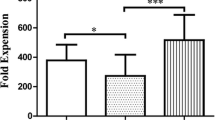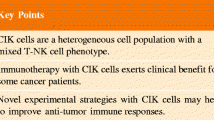Abstract
In this study, we evaluated the ability of combination regimens of interleukin-12 (IL-12) and interleukin-2 (IL-2) to induce effective killer cells against human tumors in vitro, in peripheral blood lymphocytes (PBL) from 15 cancer patients and mixed lymphocyte/tumor culture (MLTC) cells from 16 cancer patients, and carried out a phenotypic analysis of the cells responsible for the lysis of the human tumors. The freshly prepared PBL were cultivated with IL-2 alone or IL-12/IL-2 for 10 days [lymphokine-activated killer (LAK) cell generation system]. The MLTC cells (PBL cultured with mitomycin-C-treated allogeneic G-415 tumor cells for 3 days) were further cultivated with IL-2 or IL-12/IL-2 for 7 days [cytotoxic T lymphocytes (CTL) generation system]. The cytolytic activities of the lymphoid cells cultivated with IL-12/IL-2 were significantly augmented in both the LAK and CTL generation systems, as compared with those of cells treated with IL-2 alone. In the LAK generation system, the cytolytic activities of the cells cultivated with IL-12/IL-2 were significantly decreased by the method of negative selection of CD11b+ or CD56+ cells using immunomagnetic beads. The CD8+-depleted cells showed a slight decrease of activity. The killer cell activities of the CD4+-depleted cells remained unchanged. In the CTL generation system, the activity was markedly reduced by the elimination of the CD8+ or CD11b+ or CD56+ cells. The combined data suggested that IL-12/IL-2-induced killer effector cells in the LAK generation system were mainly of the natural killer (NK) type, comprising CD8−CD11b+, CD8− CD16b−, CD3−CD56+, and partly possible CD8+ CD11b−T cells. CD8+ CD11b−T cells mixed with cells of the NK type, comprising CD8−CD11b+, CD8− CD16b− and CD3−CD56+ cells, were the population of killer effector cells induced by IL-12/IL-2 in the CTL generation system.
Similar content being viewed by others
Abbreviations
- IL :
-
interleukin
- LAK :
-
lymphokine-activated killer
- CTL :
-
cytotoxic T lymphocytes
- PBL :
-
peripheral blood lymphocytes
- NK :
-
natural killer
- MLTC :
-
mixed lymphocyte/tumor cell culture
- TIL :
-
tumor-infiltrating lymphocytes
References
Andrews JVR, Schoof DD, Bertagnolli MM, Peoples GE, Goedegebuure PS, Eberlein TJ (1993) Immunomodulatory effects of interleukin-12 on human tumor-infiltrate lymphocytes. J Immunother 14:1–14
Aste-Amezaga M, D'Andrea A, Kubin M, Trinchieri G (1994) Cooperation of natural killer cell stimulatory factor/interleukin-12 with other stimuli in the induction of cytokines and cytotoxic cell-associated molecules in human T and NK cells. Cell Immunol 156:480–492
Brunda MJ, Luistro L, Warrier RR, Wright RB, Hubbard BR, Murphy M, Wolf SF, Gately MK (1993) Antitumor and antimetastatic activity of interleuklin-12 against murine tumors. J Exp Med 178:1223–1230
Chan SH, Perussia B, Gupta M, Kobayashi M, Pospisil M, Young HA, Wolf SF, Young D, Clark SC, Trinchieri G (1991) Induction of IFNγ production by NK cell stimulatory factor (NKSF): Characterization of the responder cells and synergy with other inducers. J Exp Med 173:869–879
Chan SH, Kobayashi M, Santoli D, Perussia B, Trinchieri G (1992) Mechanisms of IFNγ induction by natural killer cell stimulatory factor (NKSF/IL-12): Role of transcription and mRNA stability in the synergistic interaction between NKSF and IL-2. J Immunol 148:92–98
Ebihara T, Koyama S (1990) Functional and phenotypic characteristics of effusion-associated lymphoid cells cultured in the presence of either recombinant interleukin-2 or T-cell growth factor from malignant pleural and peritoneal effusions in patients with advanced carcinoma. Tohoku J Exp Med 162:49–63
Gately MK, Desai BB, Wolitzky AG, Quinn PM, Dwyer CM, Podlaski FJ, Familletti PC, Sinigaglia F, Chizonnite R, Gubler U, Stern AS (1991) Regulation of human lymphocyte proliferation by a heterodimeric cytokine, IL-12 (cytotoxic lymphocyte maturation factor). J Immunol 147:874–882
Gately MK, Woltzky AG, Quinn PM, Chizzonite R (1992) Regulation of human cytolytic lymphocyte responses by interleukin-12. Cell Immunol 143:127–142
Kobayashi M, Fitz L, Ryan M, Hewick RM, Clark SC, Chan S, Loudon R, Sherman F, Perussia B, Trinchieri G (1989) Identification and purification of natural killer cell stimulatory factor (NKSF), a cytokine with multiple biologic effects on human lymphocytes. J Exp Med 170:827–845
Koyama S, Fukao K (1994) Phenotypic analysis of nylon-wool adherent suppressor cells that inhibit the effector process of tumor cell lysis by lymphokine-activated killer cells in patients with advanced gastric carcinoma. J Cancer Res Clin Oncol 120:240–247
Koyama S, Yoshioka T, Mizushima A, Kawakita I, Yamagata S, Fukutomi H, Sakita T, Kondo I, Kikuchi M (1980) Establishment of a cell line (G-415) from a human gallbladder carcinoma. Jpn J Cancer Res (Gann) 71:574–575
Koyama S, Mukai R, Fukao K, Arimura H, Iwasaki Y, Osuga T (1987) Monoclonal antibody against human gallbladder carcinoma-associated antigen. Cancer Res 47:4667–4673
Koyama S, Ebihara T, Fukao K, Osuga T (1989) Differential activation of lymphokine-activated killer cells with different surface phenotypes by cultivation with recombinant interleukin-2 or T-cell growth factor in gastric cancer patients. Jpn J Cancer Res 8:150–157
Kuge S, Watanabe K, Makino K, Tokuda Y, Mitomi T, Kawamura N, Habu S, Nishimura T (1995) Interleukin-12 augments the generation of autologous tumor-reactive CD8+ cytotoxic T lymphocytes from tumor-infiltrating lymphocytes. Jpn J Cancer Res 86:135–139
Nastala CL, Edington HD, McKinney TG, Tahara H, Nalesnik MA, Brunda MJ, Gately MK, Wolf SF (1994) Recombinant IL-12 administration induces tumor regression in association with IFNγ production. J Immunol 153:1697–1706
Rabinowich H, Herberman RB, Whiteside TL (1993) Differential effects of IL-12 and IL-2 on expression and function of cellular adhesion molecules on purified human natural killer cells. Cell Immunol 152:481–498
Rossi AR, Pericle F, Rashleigh S, Janiec J, Djeu JY (1994) Lysis of neuroblastoma cell lines in human natural killer cells activated by interleukin-2 and interleukin-12. Blood 83:1323–1328
Stern AS, Podlaski FJ, Hulmes JD, Pan Y-CE, Quinn PM, Wolitzky AG, Familletti PC, Stremlo DL, Truitt T, Chizzonite R, Gately MK (1990) Purification to homogeneity and partial characterization of cyotoxic lymphocyte maturation factor from human B-lymphoblastoid cells. Proc Natl Acad Sci USA 87:6808–6812
Trinchieri G (1994) Interleukin-12: A cytokine produced by antigen-presenting cells with immunoregulatory functions in the generation of T-helper cells type 1 and cytotoxic lymphocytes. Blood 84:4008–4027
Unkeless JC (1979) Characterization of a monoclonal antibody directed against mouse macrophage and lymphocyte Fc receptors. J Exp Med 150:580–596
Wigginton JM, Komschlies KL, Back TC, Franco JL, Brunda MJ, Wiltrout RH (1996) Administration of interleukin 12 with pulse interleukin 2 and the rapid and complete eradication of murine renal carcinoma. J Natl Cancer Inst 88:38–43
Zeh HJ III, Hurt S, Storkus WJ, Lotze MT (1993) Interleukin-12 promotes the proliferation and cytolytic maturation of immune effectors: implications for the immunotherapy of cancer. J Immunother 14:155–161
Zou JP, Yamamoto N, Fujii T, Takenawa H, Kobayashi M, Herrmann SH, Wolf SF, Fujiwara H, Hamaoka T (1995) Systemic administration of rIL-12 induces complete tumor regression and protective immunity: response is correlated with a striking reversal of suppressed IFNγ production by anti-tumor T cells. Int Immunol 7:1135–1145
Author information
Authors and Affiliations
Rights and permissions
About this article
Cite this article
Koyama, S. Augmented human-tumor-cytolytic activity of peripheral blood lymphocytes and cells from a mixed lymphocyte/tumor culture activated by interleukin-12 plus interleukin-2, and the phenotypic characterization of the cells in patients with advanced carcinoma. J Cancer Res Clin Oncol 123, 478–484 (1997). https://doi.org/10.1007/BF01192201
Received:
Accepted:
Issue Date:
DOI: https://doi.org/10.1007/BF01192201




